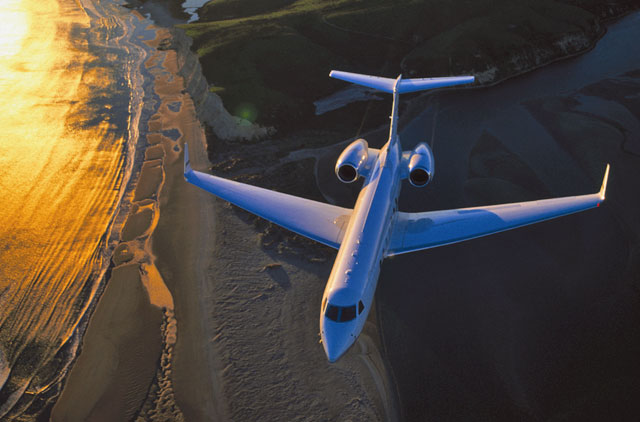Gulfstream kicked off the certification campaign for its large-cabin, long-range G600 on 17 December 2016. With the clean-sheet business jet destined for service entry in less than two years, it is only a matter of months before the company calls time on its sector rival and much older sibling, the G550, say analysts.
The US airframer says it will continue to produce the 14-year-old model for the time being. “We have and continue to see nice demand for the aircraft,” it says, describing the $61.5 million G550 as “one of the most successful aircraft for Gulfstream, with more than 500 in service”.
It says: “Customers continue to see tremendous value in the G550, with its unmatched reliability and the longest range in its class” at some 6,750nm (12,490km).
Gulfstream made a similar commitment to the G450 in mid-2015, however, when the similarly cast G500 entered its flight test campaign. Seventeen months later, and with the G500 on track to enter service in the fourth quarter of 2017, Gulfstream said it would stop manufacturing the 13-year-old model, for which it has produced more than 400 units. The final examples are set to roll off the production line next year.
Aerospace analyst Brian Foley says: “This was a planned obsolescence, and carefully orchestrated from a product strategy standpoint. The same can be said of the G600 replacing the discontinued G550. This is typical of product updates in the industry.”

Gulfstream Aerospace
When announcing new aircraft, Foley says manufacturers have to be careful not to discourage sales of the model that is to be replaced. “To prevent this, OEMs almost never announce the demise of a current product,” he says. “Instead, when publicly asked what will happen to the legacy airplane, they will almost always respond: ‘we’ll let the market decide’. When the current production line is finally sold out – as in Gulfstream’s case – they’ll finally ’fess up that the aircraft is being discontinued.”
Gulfstream does not disclose its sales backlogs, but during a third quarter earnings call last October, Phebe Novakovic, chairman and chief executive of parent company General Dynamics, acknowledged steady “order activity” for the G550, which has sold consistently well since its introduction in 2003 as the GV-SP.
Aerospace analyst Rolland Vincent describes the G550 as a “premier and sought-after classic aircraft”.
He says: “It’s the last of a highly desired breed with Rolls-Royce power,” referring to the aircraft’s BR710-C4-11 engines. The new G500 and G600 are powered by Pratt & Whitney Canada PW814 and 815GA turbofans, respectively, making them the first Gulfstream types not to have R-R engines.
“Given that the G550 flies further than the G600, there is a possibility that some buyers may be hesitant to step up into the G600 until an ER version is developed,” he adds. Vincent is referring to the 6,200nm range of the G600, which is some 500nm shorter than that of its ageing stablemate.
“While a G600ER may happen one day, Gulfstream is no doubt keen to establish clear delineation between the G600 and [7,500nm] G650,” he says.
Despite the G550s “classic” appeal, Vincent anticipates the final models will roll-off the Savannah, Georgia, production line by early 2019. “The market is already reacting to the pending entry into service of the G600, with a substantial hit to the G550’s new and pre-owned prices and residual values,” he says.
This view is echoed by Daniel Hall, senior analyst with FlightGlobal Ascend consultancy. “Pricing is coming under pressure, with residual values falling and discounts being offered on new aircraft,” he says. “Customers looking for new aircraft won’t pay the full price for a model if its value is dropping. The same can be said for used aircraft.”
According to Brendan Lodge, business development director with the aircraft brokers Aura Aviation and Jet Brokers, a 10-year-old G550 valued at $28 million a year ago is now worth $18-$20 million. Similarly, a two-year-old model has seen its value fall from around $40 million in early 2016 to around $35 million today.
Says Vincent: “This is a very sharp downturn from a few years ago, and reflects the oversupplied large-cabin market, aggressive new aircraft discounting across all OEMs to sell available production slots, and end-of-line discounting by Gulfstream that is inevitably needed to convince buyers to purchase what is soon to be an OOPS [out-of-production status] aircraft.”
Deliveries of the 18-passenger G550 have also taken a hit in recent years, according to Flight Fleets Analyzer, falling from 50 aircraft at its 2011 market peak to 19 units in 2016 – almost half the tally for 2015. The global in-service fleet totals nearly 540 aircraft today, it records, with about 40 units currently up for sale.
“My sense is that the G550 programme has exceeded Gulfstream’s expectations for total delivery volume,” Vincent says. “It has had a great run and has been the airplane of choice for many corporations and governments, particularly in the USA, Middle East and Asia Pacific.”
For customers who have selected the $54.5 million G600, the aircraft provides a plethora of enhancements over the G550.
These include a significantly improved passenger experience: a taller and wider cabin, significantly larger windows, lower cabin altitude, faster cruise speeds at long-range, and lower fuel burn and emissions. The aircraft is also fitted with the latest cockpit technology, with the Honeywell-based Symmetry flightdeck and fly-by-wire technology with active sidestick controls.
Foley says the G600 provides more benefits to Gulfstream than it does to the marketplace. “From a market standpoint, the G600 is only an evolutionary improvement to the G550. On the factory floor it will be a revolutionary improvement,” he says. “Being an all-new design, manufacturing labour hours will be drastically reduced from the aircraft today, which is based on labour rates and production techniques of the original G1 design from the 1950s. In time this should result in higher margins for the company.”
Source: Flight International



















